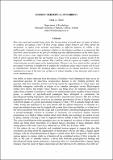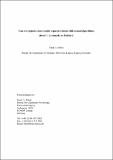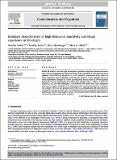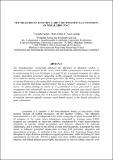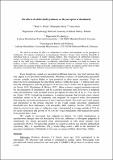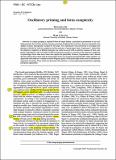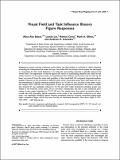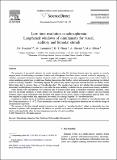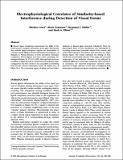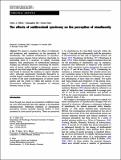Search
Now showing items 1-10 of 51
Defining perceptual synchrony
(Kijima Printing Co., 2007)
How does neuronal activity bring about the interpretation of visual space in terms of objects or complex perceptual events? If they group, simple visual features can bring about the integration of spikes from neurons ...
Can we explain cross-modal representation with neural algorithms alone?: Commentary on Paillard
(North-Holland, 1999)
Recent research in both psychophysics and electrophysiology has revealed a number of examples in which behaviour is guided by (i.e. Spence & Driver, 1996), and brain activity has been argued to correlate with, the formation ...
Bandpass characteristics of high-frequency sensitivity and visual experience in blindsight
(Elsevier, 2010-03)
Patient RP suffers a unilateral right homonymous quadrant anopia but demonstrates better than chance discrimination for stimuli presented in the blind field at temporal frequencies between 33 and 47 Hz (all significant at ...
New measures of functional (but not perceptual) continuity in visual grouping
(International Society for Psychophysics, 2004)
The benzodiazepine, Lorazepam enhances the efficiency of inhibitory GABA-A synapses in the cortex, which stabilize postsynaptic, excitatory activity by synchronizing their own discharges at around 40 Hz. Lorazepam treatment ...
The effects of subthreshold synchrony on the perception of simultaneity
(Springer, 2007)
We aimed to examine the effects of subthreshold synchrony and asynchrony on the perception of simultaneity. We rendered simultaneous or asynchronous luminance changes below detection thresholds by embedding them in a ...
Oscillatory priming and form complexity
(Psychonomic Society, 2007-02)
Detection of a target grouping is expedited when the target display is preceded by presentation of an oscillating premask that includes priming elements presented intraphasically and below detection threshold at the display ...
Visual field and task influence illusory figure responses
(Wiley, 2008-11)
In normal viewing conditions, many objects are often hidden or occluded by others, therefore restricting the information that enters the eye. One ability that the human visual system has developed to compensate for this ...
Low time resolution in schizophrenia: Lengthened windows of simultaneity for visual, auditory and bimodal stimuli
(Elsevier, 2007-12)
The guarantee of perceptual coherence for events through everyday life situations depends upon the capacity to correctly integrate series of multi-sensory experiences. Patients with schizophrenia have been shown to reveal ...
Electrophysiological correlates of similarity-based interference during detection of visual forms
(MIT Press, 2006-06)
Illusory figure completion demonstrates the ability of the visual system to integrate information across gaps. Mechanisms that underlie figural emergence support the interpolation of contours and the filling-in of form ...
The effects of subthreshold synchrony on the perception of simultaneity.
(Springer, 2007)
We aimed to examine the effects of subthreshold synchrony and asynchrony on the perception of simultaneity. We rendered simultaneous or asynchronous luminance changes below detection thresholds by embedding them in a ...

